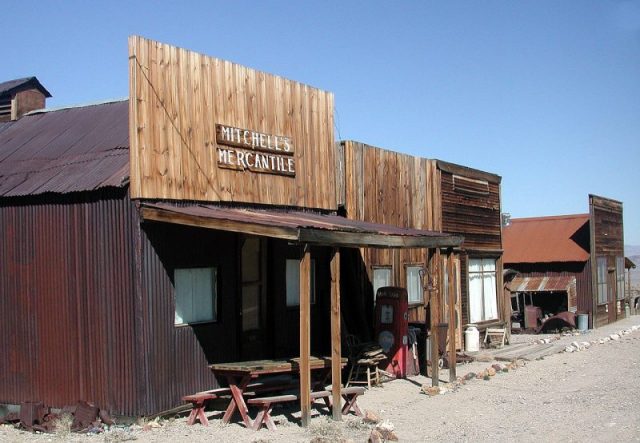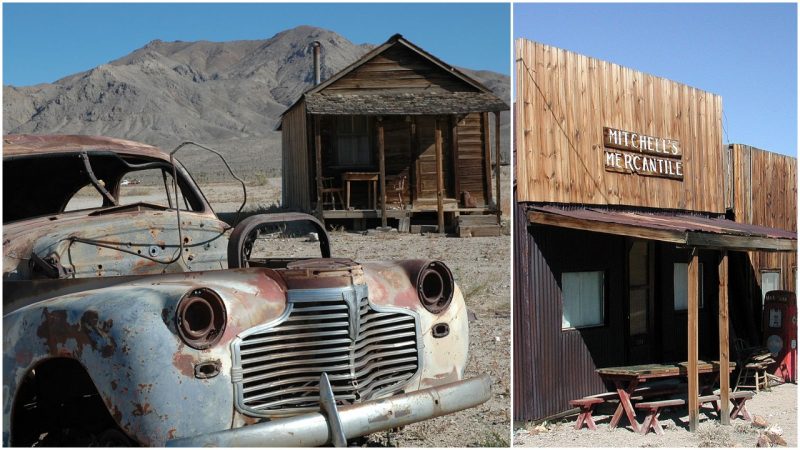Right next to Death Valley, in a barren land where almost nothing moves and a passing monsoon is perhaps the only thing that brings fresh water to the vast bone-dry desert, there lies a small settlement of just a few people that call the place home. Nevada’s Gold Point.
It’s another 19th century mining boom town turned into a ghost town that just happened to grow out of nowhere during and after the Gold Rush, the Silver Rush, or any other great rush for precious things, when humans went on to explore every piece of land and extract anything of value from the Sierra Nevadas and the plains down below.
In fact, Nevada is full of them, it is after all the Silver State, and hundreds and hundreds of towns left to ruin speak of its perhaps not long, but very rich history nevertheless.
This town, in particular, started off as a limestone camp in 1868, when huge outcrops of this sedimentary rock were discovered nearby, within 500 feet of the current town’s location. Miners rushed to dig it, and their tents filled up the land under the clear sky, as tales tell. But only for a couple of years. It didn’t last for long, and no one really knows why, but the extraction was halted and the camp abandoned completely. Perhaps the site was too far out and it was too expensive to keep it open and operating. Or those huge outcrops were not so huge after all, who knows. Maybe, and just maybe, someone screamed Gold from somewhere not so far away, and the workers, along with all others involved, left Lime Point behind and went on their way. Gold is gold after all, and limestone is just another stone.

And then there was the water, or in this case, there wasn’t. Not for miles and miles. Goldfield was arid just the same, but it had gold, lots of it. And at the start of the 20th century, it was the place to be and the place to dig. Almost 20,000 people were living or digging when the city was at its highest in 1904, many of whom went on to explore to find some more places to dig, and what do you know. Voila! The former camping ground of miners who mined and stopped for a reason that nobody really can confirm was discovered in 1905 to have huge deposits, not of gold, but close, high-grade horn silver. And there was a lot this time, really.
After the Great Western Mining Company got permission to begin an operation to extract the ore, the abandoned camp grew into a flourishing town almost immediately. According to the official Gold Point website and almost every other information source, the place, at the time named Hornsilver, of course, had virtually everything. From a telephone service, a post office and its own newspaper, the Hornsilver Herald, to bakeries, cafes, a hotel with a brothel and all kinds of stores, saloons, gold, silver, men, women, chipmunks, jackrabbits, coyotes. Anything anyone can ever want in life really.
On top of all that, it turned out that the town was in no shortage of gold. So everyone got even merrier and the town even more prosperous in 1927 when a miner, who went by the name J. W. Dunfee, saw gold glitter down in the mine.
At one point there were around 300 wooden structures where people slept, dined, drank, or anything else which can be a part of a life lived in a thriving gold and silver mining town in those days.
But then, a war happened. Life happened and people left. This arid land turned into a limestone camp, and a horn silver excavation site about two decades later, that grew into a booming gold-mining town right after, died off completely during and after the Second World War. Without interest from men, nor enough water to keep it going and a devastating accident in the 1960s that hammered its entrance to the ground to make things even harder. The mining site was closed entirely and the infrastructure was left to rot in the middle of nowhere and possibly serve as a reminisce of a bygone era. As is every other abandoned ghost town when we come to think of it.

Only, Gold Point has a very lively presence for a “ghost town,” and a few people, among whom are Herb Robbins, his partner Chuck Kremin, as well as his brother, Walt, are determined to keep it that way and not let it pass into history as just another part of Nevada’s indelible charming heritage.
“You know what? I’m not going to let that happen to Gold Point, so I’ll buy whatever I can and restore the buildings,” is what Robbins, who now owns up to 30 buildings in the city, had to say in an exclusive interview for the Los Angeles Times and the purpose of Jay Jones’ story from 2008, “Gold Point: The Nevada Ghost Town that wouldn’t Die.” And admirably, they are doing just that to the best of their abilities, to give people a different experience and a chance, as he says, to “walk around and see, visualize and imagine what this was like 100 years ago.”

The whole of Esmeralda County, Nevada, counts no more than 800 full-time residents or about a single person per five square miles. Only 6 people are permanent residents of Gold Point and just as many come from time to time to lend a hand. They are enough though, it works, at least enough to make it a precious gemstone in an arid desert to people who are willing to spend a few bucks to go back in time and enjoy a bed and breakfast in one of the original miner’s cabins.
Or they can book a tour and try to find if this ghost town is only a living lesson in history or a place where both the living and the dead reside. People were hearing strange things in this place when everything was dark and quiet and they would go for a good night’s sleep in a far-off town 300 miles south of Reno and 175 north from Las Vegas.

Some probably would be put off by this fact, but surprisingly it is one of the many reasons that most are actually drawn to this place. If you like, you can book a tour and find out if the nonliving are wandering about in the nights. And if you fail to spot one before you go to bed, don’t worry, for there is always a chance to have an unexpected visit from a jolly little jackrabbit early in the morning, so you can stare at those big ears right before breakfast as the next best thing.
Everything is intact and preserved as if nothing happened and no time had passed. There is no water in the cabins so everyone can get a full on authentic experience. But there is plenty of it down in the saloon. Along with any other drink of choice and a chance to play pool at a 1909 Brunswick pool table.
